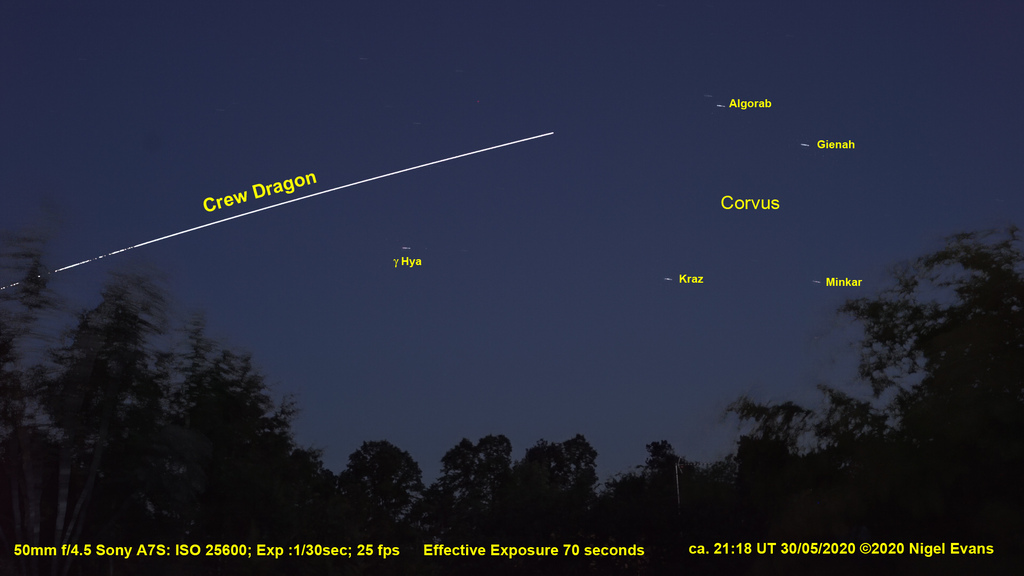
Orwell Astronomical Society (Ipswich)
Crew Dragon Capsule, 30 May 2020 - 16 September 2021
The first crewed mission of the SpaceX Dragon Capsule was originally scheduled for 27 May 2020. The aim was to ferry two astronauts to the International Space Station (ISS). The launch was cancelled at the last minute due to unsuitable weather conditions. Had launch proceeded as planned, the craft would have been visible from the UK in twilight.
Every day of delay to launch moved the launch window some 22-23 minutes earlier, bringing the passage over the UK into a brighter sky. The launch finally took place at 20:22:45 BST on 30 May, and the capsule passed over the UK in daylight some 20 minutes later. There was one opportunity to see the craft before it docked with the ISS about 19 hours later (15:33 BST on 31 May). This occurred on its second orbit, low down in the south west. The sighting opportunities were limited for me, and I had to take to an upstairs bedroom.
I should have pressed the record button earlier. The capsule was much brighter than I expected - approximately magnitude 1. In the video, Gienah is magnitude 2.6 and flickers in and out of view. The prediction in heavens-above.com gave a maximum altitude of only 11°, but in fact the pass was much higher (Algorab was at an altitude of 19°).
A subsequent opportunity to observe a Crew Dragon capsule occurred on the morning of 02 May 2021 (postponed from the morning before). This opportunity was noteworthy in that the capsule, Resilience, occupied by four astronauts returning to Earth, undocked from the ISS at 00:35 GMT and landed in the ocean some six hours later. Shortly after undocking, there was an opportunity to see the two crewed satellites at once, flying in loose formation.
The two craft passed west to east through the sky 02:20 GMT, at an altitude of only 20° in the SE. A 20-day old Moon was low on the horizon nearby. I could not get a clear view from my garden so stood in the street: I live in a cul-de-sac so this was not life-threatening. I was unsure what I would see: the ISS is large and bright but would be over 1000 km distant, and Resilience is very much smaller. The ISS duly appeared, looking rather orange because of its low altitude, but I could not see anything else with the naked eye. Binoculars easily showed another object approximately 1° ahead: this was Resilience!
My two Sony A7S cameras recorded the craft passing through Aquila. The following video is at five times live rate.
The following still is a composite of frames from the video showing the passage of the craft against a better-defined stellar backdrop.
The following video shows a higher scale view at three times live rate.
The following still is a composite of frames from the video showing the passage of the craft against a better-defined stellar backdrop.
Ten minutes after the passage of Resilience, there was a passage of the latest train of Starlink satellites (L25, launched on 29 April): it was most unimpressive.
There was a third opportunity to observe a Crew Dragon capsule in September 2021. This time, the capsule, Inspiration4, was manned by four private citizens, none of them a professional astronaut, so the mission represented a new era in commercial manned spaceflight.
The launch window was five hours wide. As the craft was not docking with ISS, there was no need to set the launch time to allow for an efficient rendezvous and docking manoeuvre. Launch duly occurred at 00:03 GMT on 16 September, and the capsule subsequently entered an orbit approximately 569 x 579 km at an inclination of 51.6°. It is expected to remain in orbit for three days.
Crew Dragon makes two passes visible from the UK each evening. Both are at low apparent altitude, with the earlier one the higher. On 16 September I set out to record the Crew Dragon passing low in the SE above Jupiter, Saturn and a 10 day old Moon. The weather forecast was not promising but, at the due time, the sky was reasonably clear - except in the direction of the capsule! The presence of patchy clouds, sometimes thick enough to obscure Saturn, made it difficult to hunt for a small moving object at a distance of 1300 km. I could not see the capsule by eye or in binoculars, but my cameras recorded it.
The following video shows a speeded-up wide-field view. It shows how much cloud there was. When I moved the camera, thinking that the best chance of recording the capsule would be in the clearer sky to the west, the craft was already in the field-of-view, although I did not know this at the time.
The following video shows a narrower view from a second camera. It includes a segment at live rate. It appears to show that the craft is flashing or tumbling: I believe that this is genuine, and not an artefact of the video.
Nigel Evans